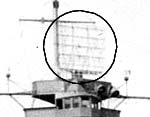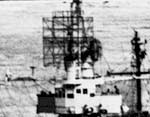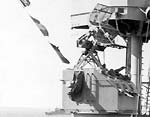Camouflage and radar were two primary defenses of
any fighting ship. Camouflage was applied with one of two aims. Low-visibility camouflage schemes
served to make the ship difficult to pick out at a distance, or from specific vantages. Some
schemes, for example, were most effective viewed from low angles - that is, from a submarine -
others strove to foil observers in the air. Measure 1, Measure 11, and Measure 21 were all
low-visibility schemes which Enterprise carried at various times in her
career.
On the other hand, disruptive or "dazzle" schemes were intended to mislead the
observer as to the ship's size, speed and direction of travel. A few such schemes - US and
Japanese - attempted disguise a vessel as an entirely different class of ship: the Japanese
carrier Zuiho, for example, had battleship
turrets painted on her flight deck at the October 1944 Battle of Leyte Gulf, where she was
sunk. The Measure 33/4ab scheme the Big E "wore" in 1944 was a disruptive scheme.
Camouflage and radar are complex subjects of study, radar particularly as it is a dynamic
system that depends on a skillful operator and appreciative commander for maximum effect.
Several useful references on these subjects are listed at the end of this page.
Camouflage
Information on Enterprise's camouflage schemes comes primarily from
Snyder & Short's Ship
Camouflage Website and Steve Wiper's Warship Pictorial #9: Yorktown Class Carriers.
David William's Naval Camouflage 1914-1945: A Complete Visual Reference is an excellent
introduction to camouflage theory and application. Color "chips" below are approximations of the
actual colors, but are not completely accurate. Snyder and Short offer very accurate
paint chip sets for model builders, available through
The Floating Drydock.
| | Purpose | Description |
|---|
Measure 1
1941 to late March 1942 |
General low-visibility scheme, which also deceived as to course when viewed
from the surface. |
| Vertical Surfaces |
Dark Gray 5-D paint applied without pattern to all vertical surfaces. Mast
and funnel tops painted in Light Gray 5-L. |
| Horizontal Surfaces |
Painted in Dark Gray 5-D, except wood decks. |
| Wood Decks |
Unpainted, except for submarines. |
|
| Dark Gray 5-D | Light Gray 5-L |
|---|
 |  |
|
Measure 11
March/April 1942 to Fall 1943 |
Very low visibility to aerial observers, but readily visible to observers at the
surface. Deceived as to course when viewed from the surface. |
| Vertical Surfaces |
Sea Blue 5-S paint applied without pattern to all vertical surfaces
including mast and funnel tops. |
| Horizontal Surfaces |
Deck Blue 20-B paint. On submarines and aircraft carriers, wooden decks
were stained to a color corresponding to Deck Blue 20-B. |
| Canvas Covers |
Stained to a color corresponding to Deck Blue 20-B. |
|
| Sea Blue 5-S | Deck Blue 20-B |
|---|
 |  |
|
Measure 21
Fall 1943 to Summer 1944
&
December 1944 to Summer 1945 |
Very low visibility to aerial observers, but readily visible to surface observers.
Like Measure 11, deceived as to course when viewed from the surface. |
| Vertical Surfaces |
Navy Blue 5-N paint applied without pattern to all vertical surfaces
including mast and funnel tops. |
| Horizontal Surfaces |
Deck Blue 20-B paint. On submarines and aircraft carriers, wooden decks
were stained to a color corresponding to Deck Blue 20-B. |
| Canvas Covers |
Stained to a color corresponding to Deck Blue 20-B. |
|
| Navy Blue 5-N | Deck Blue 20-B |
|---|
 |  |
|
Measure 33 (Variant 4AB)
Summer 1944 to December 1944 |
Anti-Submarine "dazzle" pattern. Note: all 34 variants of Measure 33 used
the same basic color selection, but differed by pattern applied. Enterprise
was the only ship painted in variant 4AB: port side view,
starboard view. |
| Vertical Surfaces |
A pattern of Haze Gray 5-H, Pale Gray 5-P and Ocean Gray 5-O paint. |
| Horizontal Surfaces |
Deck Blue 20-B (Enterprise) or Deck Green 20-G paint. Flight
decks were stained with Deck Blue Stain 21. |
| Canvas Covers |
Stained to a color corresponding to Deck Blue 20-B. |
|
| Haze Gray 5-H | Pale Gray 5-P | Ocean Gray 5-O |
|---|
 |  |  |
|
Radar ("Radio Detection And Ranging") was a revolutionary development that eventually
altered nearly every aspect of naval combat. Aircraft carriers generally employed air search and
fire control radars. Air search radar probed for aircraft. While maximum range varied with the
target's altitude and size, naval air search radar of the time was capable of detecting aircraft
60-100 statute miles away: sometimes more. Air search radar was often augmented with height
finder radar - to determine a target's altitude - and IFF (Identification Friend or Foe) systems,
an automated mechanism for distinguishing friendly aircraft from those of the enemy.
CXAM-1 Search Radar
| Description: | A large mattress-like antenna, the CXAM-1 was an improved
version of the Navy's prototype search radar, the CXAM. Enterprise's
sister ship, Yorktown CV-5 was the first US carrier fitted with
radar, a CXAM. Installations of CXAM-1 sets began in late 1941, with some sets remaining
in service through 1943. |
| Range: | Capable of detecting large aircraft at 10,000 feet altitude at
70 nautical miles (80.5 statute miles), or fighters (small aircraft) at 10,000 feet
altitude at 50 nautical miles (57.5 statute miles). |
| Accuracy: | 200 yards. |
|
 |
|
SC-2 Search Radar
| Description: | A second-generation air search radar, the SC-2 was
approximately half the size of the CXAM-1. It included an integral IFF (Identification
Friend or Foe) system and limited altitude detection capabilities. An SC-2 set was
installed as Enterprise's secondary search radar in late 1942,
mounted on the starboard side of her funnel. |
| Range: | Capable of detecting large aircraft at 10,000 feet altitude at
80 nautical miles (92 statute miles), or fighters at 10,000 feet altitude at 40
nautical miles (46 statute miles). |
| Accuracy: | 100 yards. |
|
|
|
SK Search Radar
| Description: | Essentially an SC-2 with a larger (CXAM-sized) antenna.
Capable of detecting a medium bomber at 10,000 feet and 100 nautical miles,
Enterprise's SK set was installed during her fall 1943 refit
at Bremerton, Washington, replacing the CXAM-1 set, along with an SM height finder.
The SC-2 secondary search radar was retained. |
| Range: | Capable of detecting large aircraft at 10,000 feet altitude at
100 nautical miles (115 statute miles). The SM height finder, located atop and at the
rear of Enterprise's tripod mast, could detect large aircraft
at 10,000 feet altitude at 50 nautical miles (58 statute miles). |
| Accuracy: | 100 yards; SM accuracy was 200 yards, or 500 feet in elevation. |
|
 |
|
Directors and Fire Control Radar
Fire (as in "gun fire") control radar was optimized to detect and track specific
targets, forming a critical input to fire direction systems. Fire control directors solved the
complex problem of aiming a weapon based on the target's range, speed and direction and the
ship's own movement (including roll). The calculated solutions guided the aiming and firing of
shipboard weapons. Typically, larger weapons - such as 5" and 40mm anti-aircraft weapons -
benefited most from fire control radar, as they tended to engage their targets at long range and
low rates of fire. Each of Enterprise's directors could provide range and
direction data for two 5" gun groups. Following her 1943 refit, her directors could also be
coupled to the quad 40mm guns to provide range data only.
John Campbell's Naval Weapons of World War Two and Norm Friedman's Naval
Radar are good general references. Information regarding Enterprise's
gunnery and radar systems can be found in Friedman's U.S. Aircraft Carriers: An Illustrated
Design History and Steve Wiper's Warship Pictorial #9: Yorktown Class Carriers.
Mk 33 Director
| Description: | A power-driven fire control director, capable of
obtaining firing solutions for targets moving at up to 320 knots, or 400 knots in
a dive. Designed and initially installed without fire-control radar. |
| Installations: | 1941 - Mid 1942:Two Mk 33 directors mounted fore and
aft of the island. No fire-control radar. |
| | Late 1942 - 1943: Two Mk 33 directors with Mk 4 fire-control
radar. The Mk 4 could detect large aircraft at up to 40,000 yards with an accuracy of
40 yards. It was less effective against low-flying aircraft and only capable of
detecting large surface ships at 30,000 yards. |
|
|
|
Mk 37 Director
| Description: | A fully-enclosed, power-driven fire control director,
designed to accommodate fire-control radar. In addition, certain components of the Mk
37 were located in armored compartments below decks, including the firing solution
"computer" itself. Capable of obtaining firing solutions for targets moving at up to
400 knots level speed, and up to 250 knots vertically. |
| Installations: | Late 1943 - 1945: Two Mk 37 directors mounted fore
and aft of the island, with Mk 12 fire-control radar. The Mk 12 could detect aircraft
at 45,000 yards with an accuracy of 20 yards, or ships at 40,000 yards. |
|
 |
|
Mk 51 Director
| Description: | A simple, one-man director, equipped with an Mk 14
gyrosight. The gyrosight, developed at MIT, computed the gun's lead angle as the
target was tracked by line-of-sight. Aboard Enterprise, Mk 51
directors initially controlled 40mm guns, but during her 1945 refit, additional
Mk 51's were installed for directing the 5"/38 guns against close-in targets. |
| Installations: | Late 1943 - 1945: At least
one Mk 51 director was installed, at the bow of the ship, connected to the twin 40mm
gun at the same location. It appears that 4-6 other Mk 51 directors were installed at
locations along the gun galleries, but this hasn't been confirmed. |
| | 1945 (post-refit): Four Mk 51 directors, each
connected to one pair of 5"/38 guns, plus seven directors for control of individual
40mm mounts. |
|
|
|
Postwar Directors
| As part of her final refit in Puget Sound Navy Yard in 1945,
Enterprise was fitted with four Mk 57 directors for the 5"/38
guns and adjacent 40mm Bofors mounts, four Mk 63 directors, each capable of operating
with two or three 40mm mounts, four Mk 51 directors for directing the 5"/38 guns to
close-in targets, seven Mk 51 directors for control of individual 40mm mounts, and
two Mk 37 directors in the island: a total of 21 directors in all. |
|
|
|











